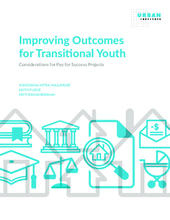Executive Summary
Transitional youth are young people ages 16 to 24 who leave foster care without being adopted or reunited with their biological families and/or who are involved in the juvenile justice system, where they may be in detention or subject to terms of probation. With childhoods often marked by trauma and a lack of stability, transitional youth face notoriously poor outcomes across many areas of life. Compared with their peers, they experience more interactions than average with the criminal justice system; suffer from mental health problems at higher rates; and struggle to complete postsecondary education, obtain and maintain employment, and secure stable housing.
The poor outcomes of transitional youth constitute a significant burden to public systems, and funding to support transitional youth can be limited and fragmented across systems and levels of government. Pay for success (PFS) may be one mechanism to fund programs that support improved outcomes for transitional youth. PFS is a form of outcomes-based financing in which private investors or philanthropies provide up-front capital to implement or scale an evidencebased social program. If an independent evaluator determines that the program achieved the desired outcomes—such as increasing high school graduation rates or reducing jail-bed days—the government will repay the initial investment with a potential return. PFS may provide an opportunity to address some of the challenges faced by transitional youth and the difficulties in serving them. For example, there are often clear gaps in services for transitional youth because they age out of care and because of varied funding sources that may not cover youth once they leave care. PFS can be used to scale or implement new programs that may fill these gaps. Further, because transitional youth are frequently involved in multiple systems, PFS may provide a cost-efficient way of paying for services by distributing the end payments among agencies that would benefit from improvements in certain outcomes.
To further explore this opportunity, the Urban Institute initiated a Community of Practice. The Community of Practice was a collaborative of researchers, practitioners, and local government officials that came together to discuss the most pressing challenges facing youth aging out of foster care and/or involved in the juvenile justice system and the potential for PFS to fund programs that address these challenges. This brief summarizes insights drawn from Community of Practice conversations and provides recommendations for local governments, service providers, and other partners considering PFS as a tool for financing interventions serving transitional youth. These recommendations are as follows:
▪ To manage reputational risk when implementing a new program, government partners can request that the PFS contract include an early termination clause allowing the government to end a project early if interim results suggest it is not working as intended.
▪ Those engaging in a PFS project should work with familiar partner organizations to help smooth an unfamiliar process. This can be accomplished by, for example, reaching out to existing funders or deepening existing relationships with service providers.
▪ Partners should identify the government entities that would benefit directly from a successful PFS project serving transitional youth in order to more cost-effectively pay for services and remove the disproportionate financial burden on any one agency.
▪ Differences in PFS stakeholder priorities can make consensus difficult, which is why outcomes should be transparent, collaborative, and include youth voices to help partnering jurisdictions and organizations think about which outcomes are important to their community.
▪ Programs for transitional youth are typically multidimensional and target many outcomes, but PFS repayments are typically based on one or two outcomes. Jurisdictions should track other outcomes of interest in addition to the repayment outcomes to build evidence and engage project stakeholders with other interests.
▪ The evidence base on programs specifically tailored for transitional youth is relatively limited. Partners could adapt an evidence-based program originally meant for a different or broader population for use in a PFS project serving transitional youth. In this way, PFS could be used as a vehicle to evaluate a promising program for transitional youth that may lack a rigorous evidence base.
▪ Whether or not a PFS project ultimately goes forward, organizations can use the exploration of PFS feasibility to initiate new partnerships and better coordinate around common outcomes.

